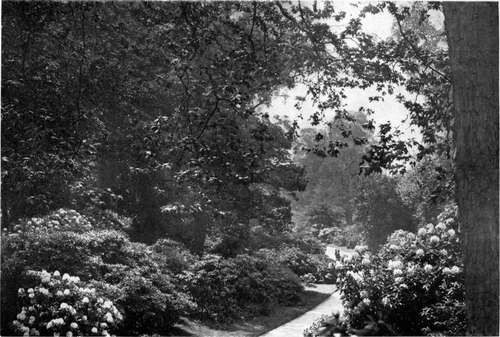Chapter XV. English Effects With Broad Leaved Evergreens
Description
This section is from the book "What England Can Teach Us About Gardening", by Wilhelm Miller. Also available from Amazon: What England Can Teach Us About Gardening.
Chapter XV. English Effects With Broad Leaved Evergreens
We may get only three fourths of the English luxuriance, but we have more native species — Seven effects we can have and four we can't.
IT IS no wonder that the myriads of Americans who visit England every year become intoxicated with the beauty of the broad-leaved evergreens. The first glimpse of the rhododendrons in Rotten Row is enough to turn any one's head, and the Americans who crowd into the big tent at the inner circle, Regent's Park, to view that matchless colour show in June, can hardly wait to get back home and begin planting. For, in England, any one can see that broad-leaved evergreens are the most sumptuous plants in cultivation. True, pines and other narrow-leaved evergreens are also attractive the year round, and many of them attain far grander dimensions, but they do not have gorgeous flowers or red berries that last all winter. Moreover, conifers as a class are a little inclined to coldness and monotony, while the broad-leaved evergreens, from the greater breadth and lustre of their leaves, are pleasanter to live with the year round. For the immediate environment of a house, broad-leaved evergreens are certainly the most desirable plants in the world, while tall conifers are quite unsuited to that position.
But the most precious quality in broad-leaved evergreens is a certain mystic charm which has nothing at all to do with showy flowers or berries. It resides in the foliage. Every one feels it, but I have never seen any attempt to express or explain it, or even a name for it. I venture to call it the "classic" effect, because the first glimpse of a Greek temple in England framed by luxuriant masses of rhododendron, box, and holly overwhelms one with feelings that seem to well up from the depths of the soul. They are deeper than the instinct that England is "our old home." One might almost call them memories of a previous existence. There is a sudden consciousness that we, too, once lived in Italy — that Greece also is our old home (see plate 64).
I know I spoil this by talking about it, because words are such frightful liars, but I feel assured that the secret of all "garden magic" is simply the power which old plants and old gardens have of stimulating the imagination, or, as I like to say, these old memories * Every one knows a few precious moments in life when a sense of the brotherhood of man floods the consciousness. So every one who sees in England this combination of classic architecture and'broad-leaved evergreens is momentarily transported in spirit to Italy and Greece, or, at least, feel some dim sense of kinship with the mighty past.
Yet the plants I spoke of are not Italian symbols. Rhododendron, box, and holly may flourish in the Mediterranean region, but they are surcharged with British feelings. The master-words to the Italian are laurel, myrtle, and olive. And right here rises our great hope. For if England can transport those who behold her gardens, though she lacks the older symbols, so America may perform this miracle, though she may use American symbols. And these symbols, if I am any prophet, will be American rhododendrons, holly, and mountain laurel.
* Oliver Wendell Holmes, in "Elsie Venner", says: "They walked over the crackling leaves in the garden, between the lines of box, breathing its fragrance of eternity; for this is one of the odours which carry us out of time into the abysses of the unbeginning past — if we ever lived on another ball of stone than this, it must be that there was box growing on it." See also Alice Morse Earle's chapter on box edgings in her "Old Time Gardens".

THE TYPICAL "SPRING GARDEN IN ENGLAND -A COLLECTION OF RHODODENDRONS, WHICH IS OFTEN COMBINED WITH AZALEAS. MANY VARIETIES, ALL COLOURS, A WINDING WALK, DIFFERENT LEVELS — NEW PICTURES AT EVERY STEP. KEW. See page 167.
But the best things nearly always cost the most. Not only are the plants themselves very expensive, but the preparation of the beds is also a serious matter, while the arrangement of the plants (so as to prevent colour discords, etc.) is so beset with pitfalls that a landscape designer is really needed for any work involving an expense of one hundred dollars or more. Also the plants are slow growers. The only consolations are that when they once get settled they last a lifetime, and the cost of maintenance is small, the chief items being the annual mulch and picking off the young seed pods. But gardening is not the cheapest game in the world and the first cost of broad-leaved evergreens is so appalling to a beginner that most Americans steer their bark against Scylla or Cha-rydbis, i. e., they skimp on cultivation or buy cheap "Dutch stuff".
Continue to:
Tags
garden, flowers, plants, England, effects, foliage, gardening
